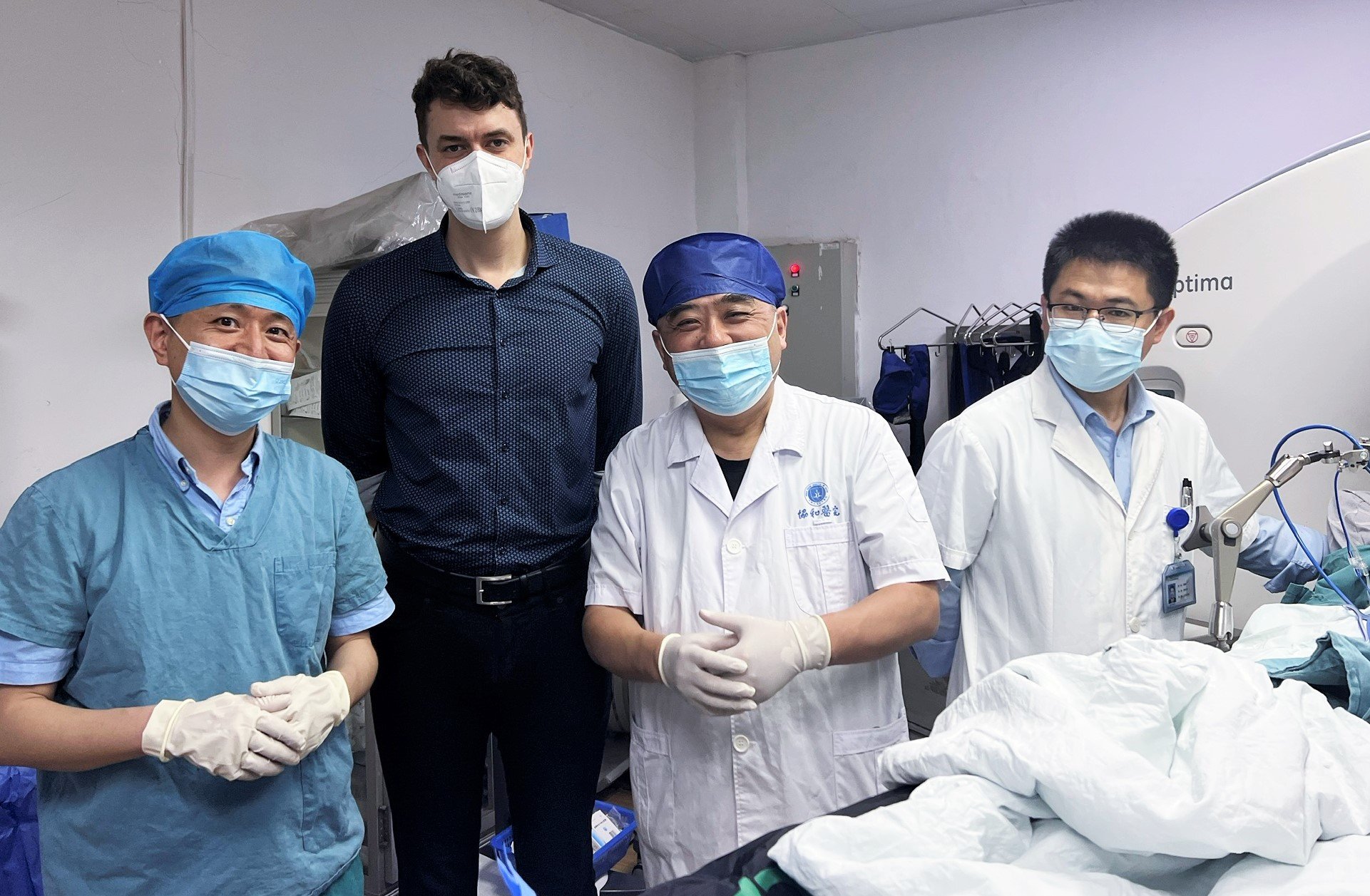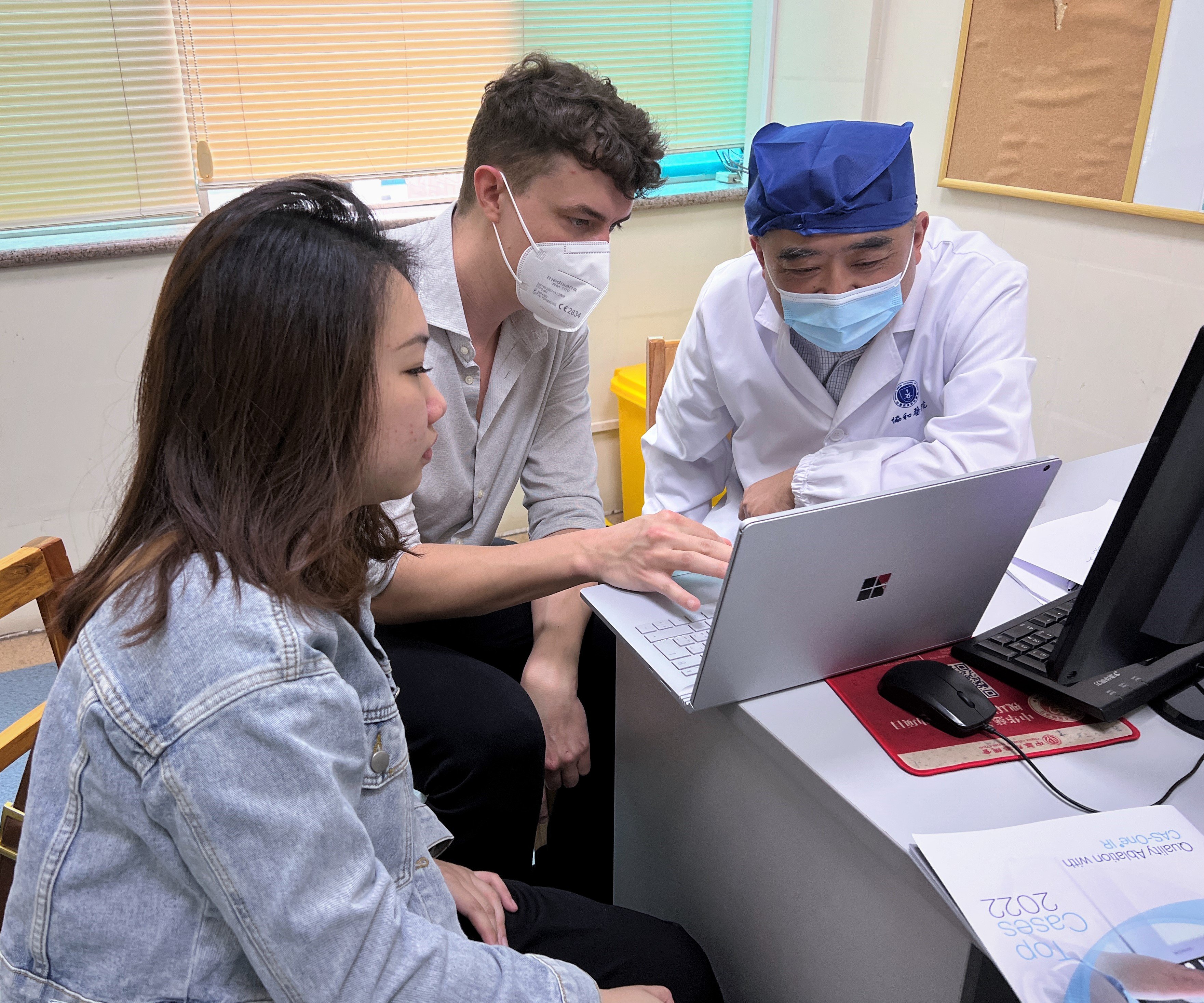CAS-One IR in China
Introducing a new era for Quality Ablation, the early months of 2020 marked a significant achievement as the CAS-One IR technology was cleared for clinical use in China. In collaboration with our distribution partner in Nanning, we successfully introduced the first systems to hospitals in China. However, the rapid adoption faced challenges due to the Covid-19 pandemic. At the time, our team was unable to travel to China, which meant we had to provide remote assistance, observe, and provide advice as our technology was introduced to the clinical community in places like Beijing, Shanghai, Suzhou, Wuhan, and Zhengzhou. As borders reopened in the spring of 2023, our colleague Dr. Benjamin Eigl embarked on a tour to visit CAS-One IR sites, engage with the Chinese clinical user community and study the use of our technology in China.

Figure 1: Captivating Shanghai: A Breathtaking View from the Shanghai Tower
Facts about ablation in China
China has the highest rates of lung cancer in the world, with 52.06 cases and 48.87 deaths per 100,000 annually. Surgical resection is gold standard for lung cancer, with approximately 80% of cases being unresectable. In addition, Liver cancer ranks third in incidence (27.04 cases per 100,000) and second in mortality (23.72 deaths per 100,000).1
China's hospitals are classified into primary, secondary, and tertiary centers, based on medical expertise, equipment, and services offered and are subject to varying levels of resources, specialization, and patient capacity. This ensures optimal patient and treatment allocation pertaining to individual needs and case complexity.
In the recent years, CT-guided microwave ablation of cancer in the liver and the lung has grown to be an important treatment modality within Chinese healthcare system. One important aspect of CT guidance is its general applicability across the entire range of organs in the ventral body cavity. The sheer volume of CT-guided interventions cases in China is staggering – with multiple that we visited doing more than 5,000 procedures per year (ablations and biopsies).
Most notably and in contrast to our western perspective, CT-guided ablations are predominantly conducted with local anesthesia (90%). This departure from general anesthesia is justified due to the considerable caseload, providing time-saving benefits both before and after the intervention.
However, nerve blocks seem to be used before the ablation procedure to reduce pain (in parallel to another intervention), demonstrating the efficiency of the care team and the potential for parallel induction anesthesia.
Shanghai
During the initial weeks, Dr. Eigl conducted visits to five hospitals in Shanghai, where he observed and discussed current practices with physician users. The doctors at Shanghai Xinhua Hospital shared their feedback on their experience with CAS-One IR. They particularly highlighted the usefulness of the multi-needle planning capabilities and the integration of 3D visualization, which greatly supported them during CT-guided lung ablations.
While the overall practices align with other international clinics, Renji Hospital has recently showcased the safe and effective utilization of blunt tip MWA electrodes for treating ground-glass opacity nodules. The blunt tip needle has a rounded atraumatic tip that spares critical structures, effectively preventing iatrogenic injuries that can result from tissue resistance.2
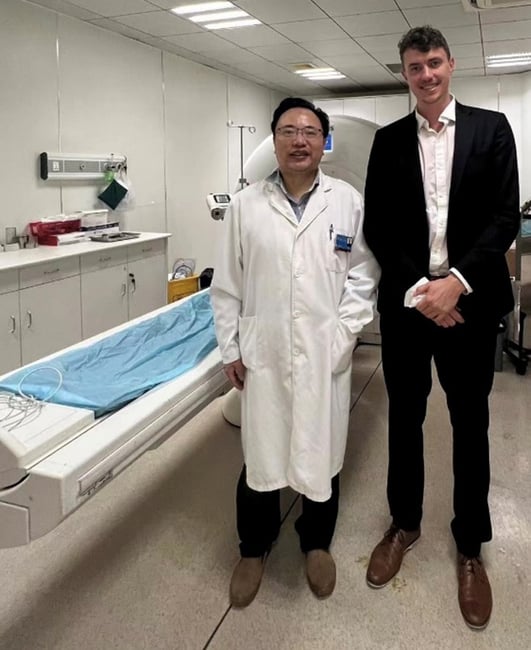
Figure 2: Post-case Reflection with Dr. Liang at Shanghai Ninth Hospital.
From Shanghai, the bullet train swiftly transported Dr. Eigl approximately 900 kilometers into central China in a mere four hours. The speed and efficiency of the journey was impressive and landscapes were so diverse, and also a bit distracting while also preparing for an important meeting with one of our esteemed CAS-One IR "power users".
Wuhan
The following day, he was warmly welcomed by Prof. Zheng at Wuhan Union Hospital. During their conversation, they had a productive and insightful discussion about Dr. Zheng and his colleagues' extensive experience, which encompassed over 50 CAS-One IR cases. Their valuable insights provided valuable guidance for future improvements.
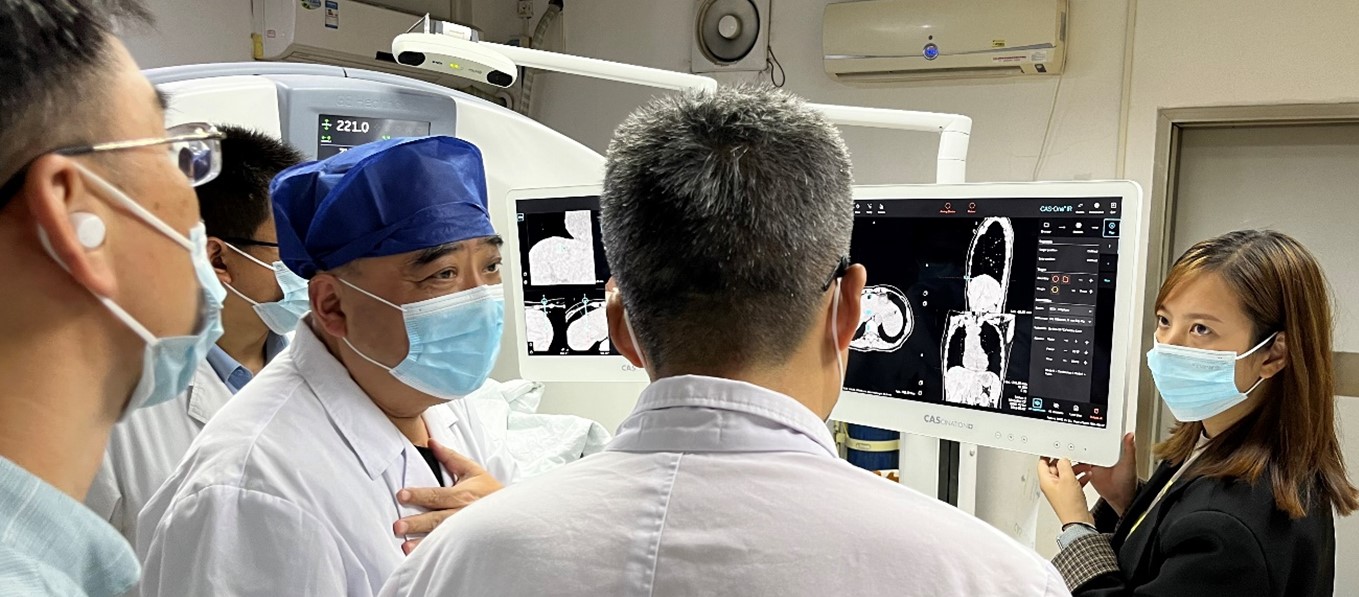
Figure 3: Prof. Zheng trains usage of CAS-One IR to his colleagues from a partnering hospital in Wuhan ahead of a case.
In the following days, in cooperation with our partners, we successfully installed a system in a hospital in Wuhan. What makes this endeavor intriguing is, that the hospital is presently undergoing an upgrade to become a tertiary healthcare facility with a specific focus on establishing a professional interventional ablation program. Prof. Zheng and Dr. Cheng supported CASCINATION during the onboarding of their local colleagues with their expertise. In the initial CAS-One IR case, a subphrenic liver tumor was successfully ablated. To enhance the procedure's planning, the intraoperative native CT scan was fused with the diagnostic image, allowing for augmented visualization. This particular feature is becoming more prevalent in our centers, especially in cases where intraoperative contrast administration is not feasible.
Suzhou
Business in China operates with remarkable agility. When Director Yin Jong from Suzhou reached out to us to evaluate the CAS-One IR system at his hospital, we wasted no time. We swiftly packed our belongings and made our way back towards Suzhou, which is located near Shanghai. Thanks to the efficiency of bullet trains, the vast distances seemed inconsequential. Just one day later, we successfully installed another system, again 900 km away from yesterday.
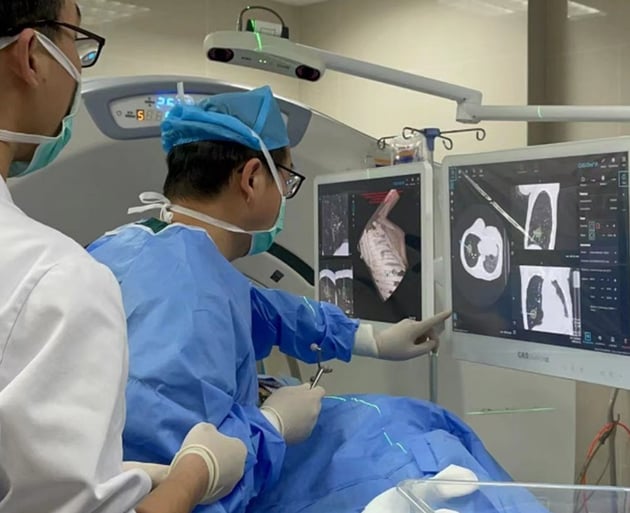
Figure 4: Trajectory planning of a CT-guided lung ablation at Suzhou hospital
Over the following two consecutive days, we conducted training sessions for the local physicians and performed three interventions utilizing CAS-One IR. These interventions included a lung biopsy, another lung ablation, and an ablation of three liver tumors. For the ablations, the hospital routinely performs a nerve-block to reduce patient discomfort during the application of thermal energy.
Zhengzhou
With a packed schedule, there was little time for reflection and Dr. Eigl found himself heading to his next destination just two days later. The final stop was Zhengzhou, the capital city of Henan Province and renowned as one of China's eight historical capitals. Our goal was to set up CAS-One IR at the First Affiliated Hospital, a renowned institution with over 7,000 beds and perhaps the most impressive infrastructure that he had the opportunity to witness during the visit.
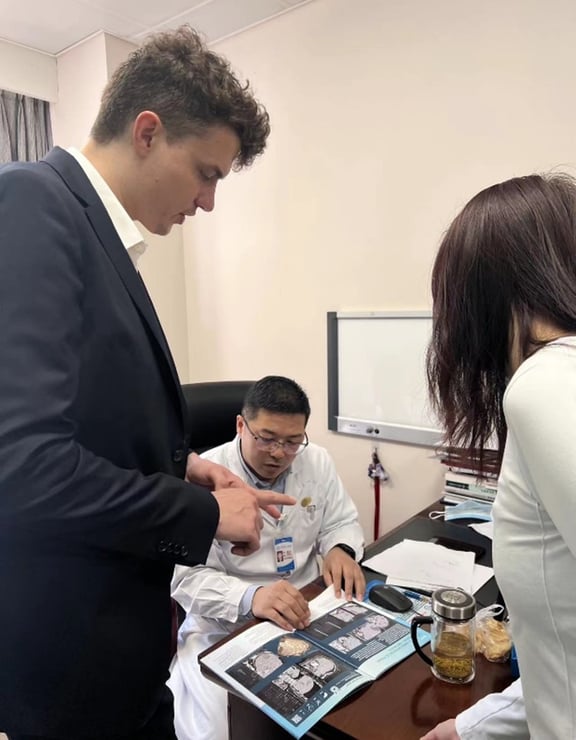
Figure 5: Discussion of CAS-One IR top cases with the leading IR
During the subsequent days, Dr. Eigl had the privilege of observing the clinical routine of a team that performed over 20 interventions per day. CAS-One IR proved to be a valuable support system for the doctors, particularly during two challenging cases: a lung ablation and a deep liver lesion. The First Affiliated Hospital showcased remarkable clinical expertise and advanced practices. What we learned was, that despite the patient being awake during the procedure, the utilization of our advanced planning and guidance technology can help to reduce the amount of attempts to place instruments, thus also reducing radiation and procedure time.
Conclusion
In conclusion, CT-guided ablations using CAS-One IR in China are impacted by several factors that play a crucial role in shaping the implementation and outcomes Quality Ablation. First, the low prevalence of general anesthesia is a challenge that requires further attention and improvements to ensure patient comfort and technical success during ablations. Secondly, the importance of lung ablations is evident, with a notable focus on addressing lung-related conditions using CT guidance. Finally, the sheer volume of procedures being performed highlights the widespread adoption and utilization of CT-guided ablations in China, emphasizing the need for optimized workflows and continuous advancements in technology and techniques to meet the growing demand and ensure optimal outcomes.
CASCINATION would like to thank Daniel Bont and Thaddäus Müller, who supported us with their knowledge and contacts during multiple attempts to travel to China last year.
References
- Chen, R. Zheng, T. Zuo, H. Zeng, S. Zhang, and J. He, “National cancer incidence and mortality in China, 2012,” Chinese J. Cancer Res., vol. 28, no. 1, p. 1, Feb. 2016, doi: 10.3978/J.ISSN.1000-9604.2016.02.08.
- Chi, J., Wang, Z., Ding, M. et al. Technical safety and efficacy of a blunt-tip microwave ablation electrode for CT-guided ablation of pulmonary ground-glass opacity nodules. Eur Radiol 31, 7484–7490 (2021). https://doi.org/10.1007/s00330-021-07774-4
- (2020). Stereotactic Image-Guided Microwave Ablation for Malignant Liver Tumors—A Multivariable Accuracy and Efficacy Analysis. Frontiers in Oncology, 10(June), 842. http://doi.org/10.3389/fonc.2020.00842
